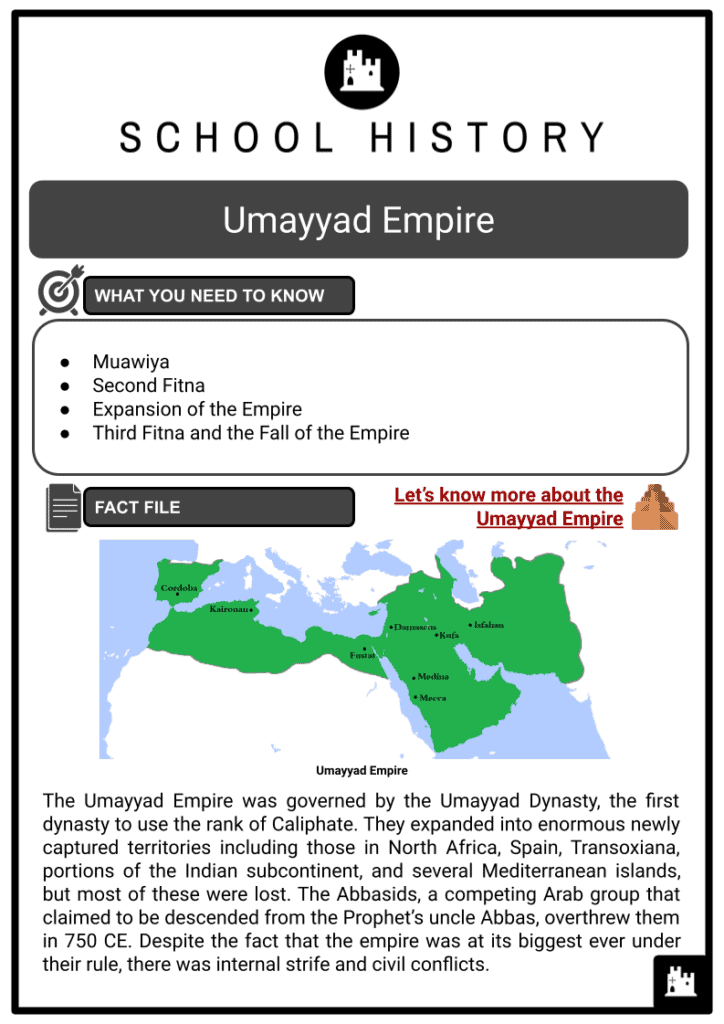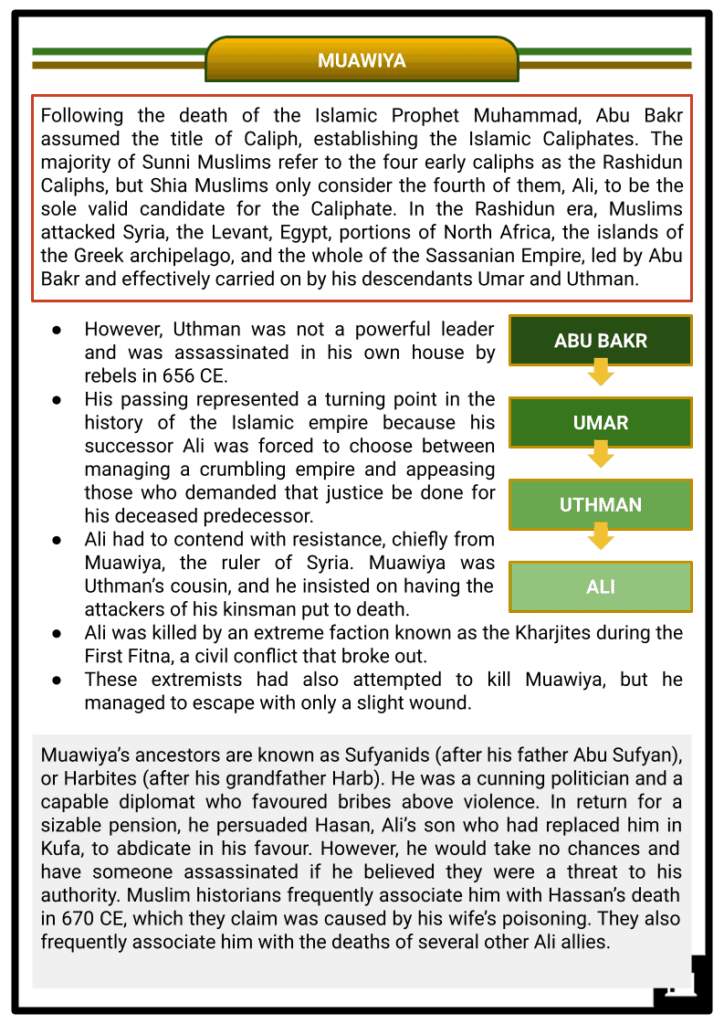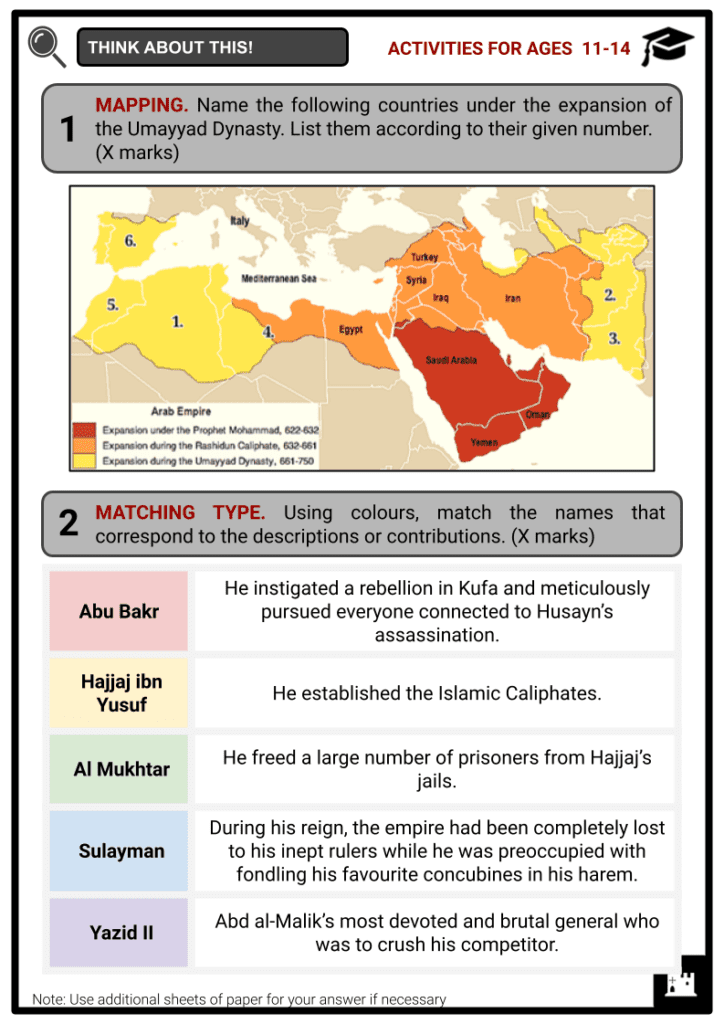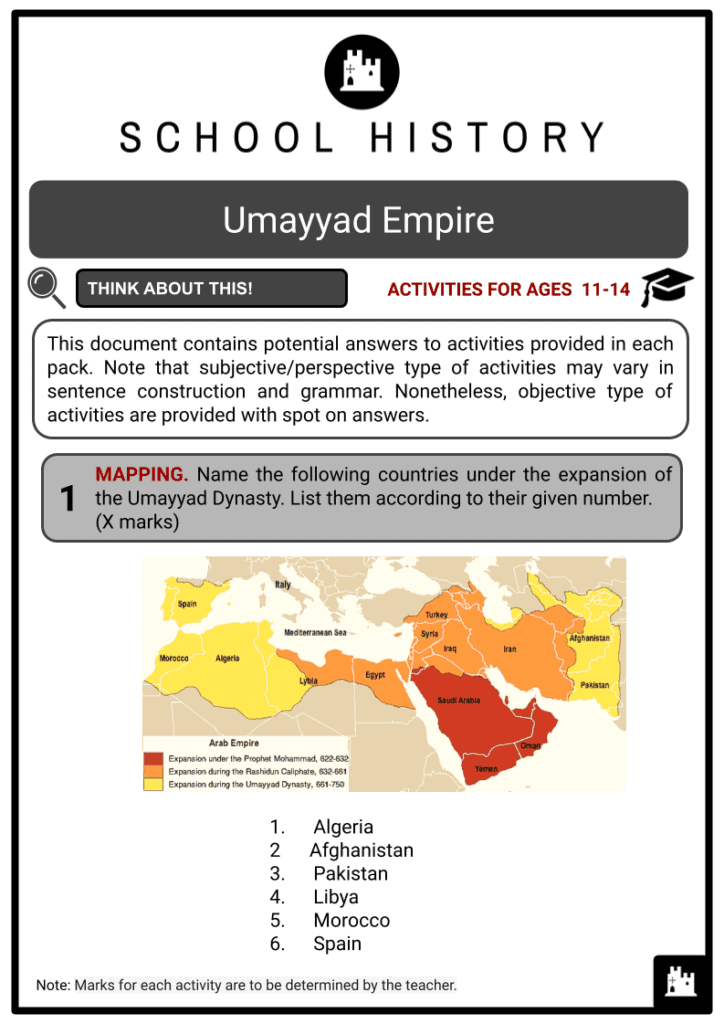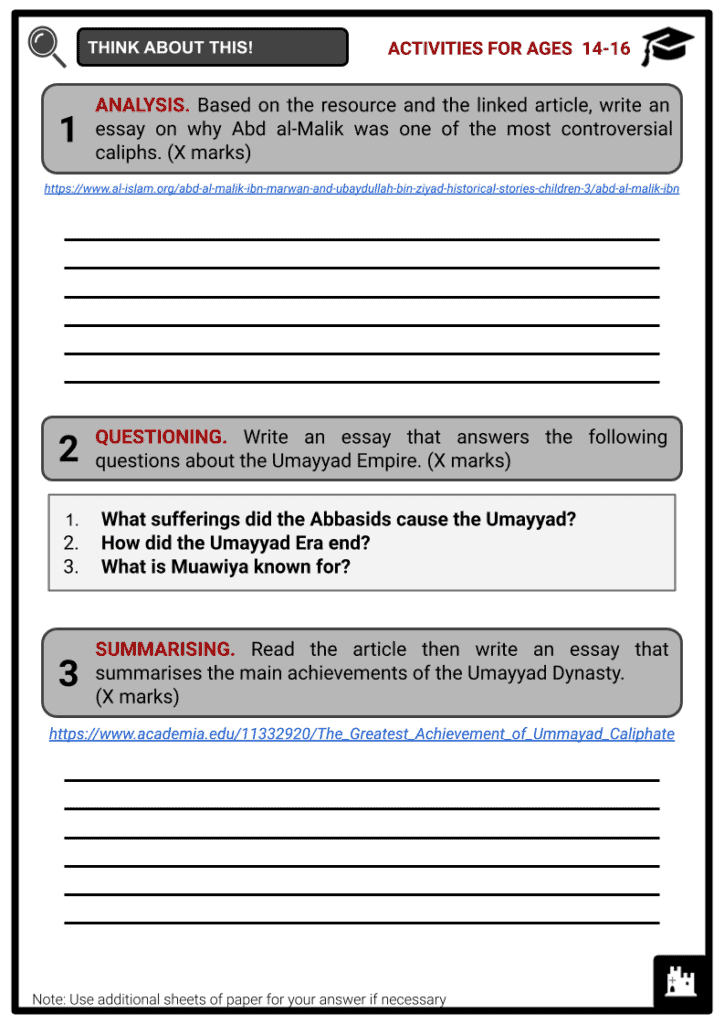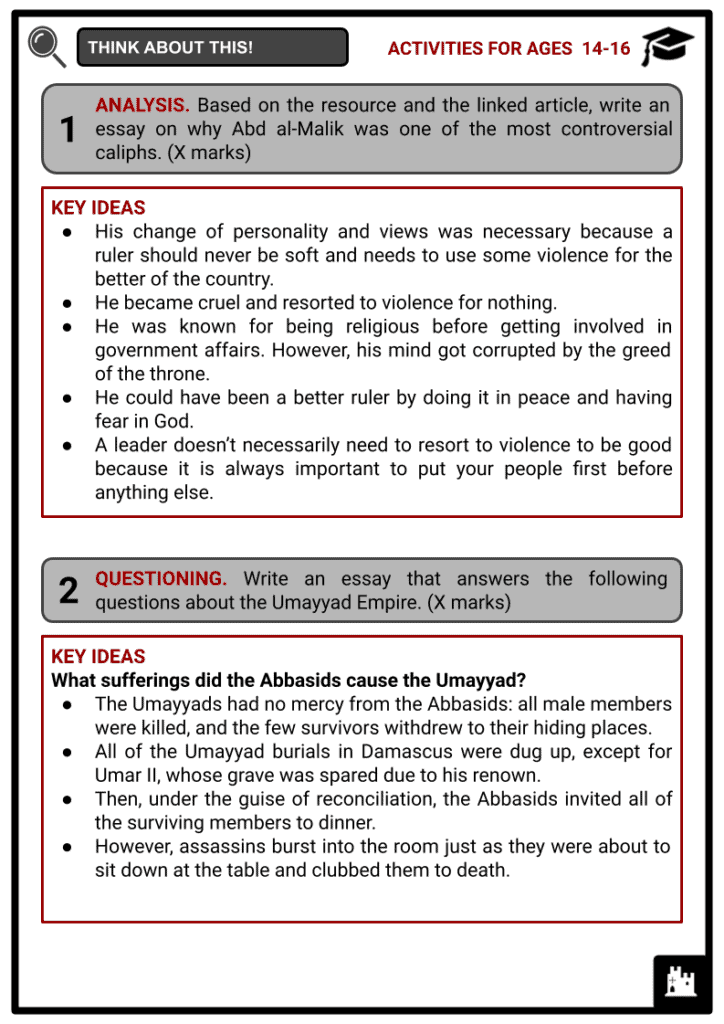Umayyad Empire Worksheets
Do you want to save dozens of hours in time? Get your evenings and weekends back? Be able to teach about the Umayyad Empire to your students?
Our worksheet bundle includes a fact file and printable worksheets and student activities. Perfect for both the classroom and homeschooling!
Summary
- Muawiya
- Second Fitna
- Expansion of the Empire
- Third Fitna and the Fall of the Empire
Key Facts And Information
Let’s know more about the Umayyad Empire!
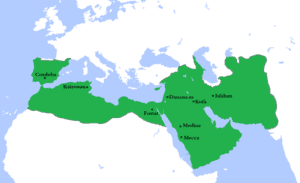
The Umayyad Empire was governed by the Umayyad Dynasty, the first dynasty to use the rank of Caliphate. They expanded into enormous newly captured territories including those in North Africa, Spain, Transoxiana, portions of the Indian subcontinent, and several Mediterranean islands, but most of these were lost. The Abbasids, a competing Arab group that claimed to be descended from the Prophet’s uncle Abbas, overthrew them in 750 CE. Despite the fact that the empire was at its biggest ever under their rule, there was internal strife and civil conflicts.
MUAWIYA
- Following the death of the Islamic Prophet Muhammad, Abu Bakr assumed the title of Caliph, establishing the Islamic Caliphates. The majority of Sunni Muslims refer to the four early caliphs as the Rashidun Caliphs, but Shia Muslims only consider the fourth of them, Ali, to be the sole valid candidate for the Caliphate. In the Rashidun era, Muslims attacked Syria, the Levant, Egypt, portions of North Africa, the islands of the Greek archipelago, and the whole of the Sassanian Empire, led by Abu Bakr and effectively carried on by his descendants Umar and Uthman.
- However, Uthman was not a powerful leader and was assassinated in his own house by rebels in 656 CE.
- His passing represented a turning point in the history of the Islamic empire because his successor Ali was forced to choose between managing a crumbling empire and appeasing those who demanded that justice be done for his deceased predecessor.
- Ali had to contend with resistance, chiefly from Muawiya, the ruler of Syria. Muawiya was Uthman’s cousin, and he insisted on having the attackers of his kinsman put to death.
- Ali was killed by an extreme faction known as the Kharjites during the First Fitna, a civil conflict that broke out.
- These extremists had also attempted to kill Muawiya, but he managed to escape with only a slight wound.
- Muawiya’s ancestors are known as Sufyanids (after his father Abu Sufyan), or Harbites (after his grandfather Harb). He was a cunning politician and a capable diplomat who favoured bribes above violence. In return for a sizable pension, he persuaded Hasan, Ali’s son who had replaced him in Kufa, to abdicate in his favour. However, he would take no chances and have someone assassinated if he believed they were a threat to his authority. Muslim historians frequently associate him with Hassan’s death in 670 CE, which they claim was caused by his wife’s poisoning. They also frequently associate him with the deaths of several other Ali allies.
- His administration reforms were equally good, including the use of a police system (Shurta), private security detail for his safety, and diwans (for district authorities, just as Umar had established).
- His 20-year rule, from his capital at Damascus, was in fact the most stable that the Arabs had witnessed since the death of Umar. He started campaigns in areas of what are now Pakistan and Afghanistan, as well as in the west all the way to Morocco’s Atlantic coast. He was successful in regaining Byzantine-lost territory, but internal strife led to the majority of his achievements being undone after his passing.
SECOND FITNA
- When Muawiya designated his son Yazid as his heir, problems emerged. Yazid’s ascension was received with a great deal of hatred because the Arabs were not used to dynastic leadership, especially from Husayn ibn Ali, Hasan’s younger brother, and Abdullah ibn Zubayr, who was the son of a close colleague of the Prophet Muhammad. Husayn marched to Iraq in 680 CE with the intention of gathering his troops and then attacking Damascus. However, Yazid placed Kufa under siege and dispatched his army, led by his cousin Ubaidullah ibn Ziyad, to ambush Husayn’s force.
- The two sides met in Karbala, close to the Euphrates, where Husayn’s army, numbering around 70 soldiers (mainly family and close friends), staged a valiant fight before being mercilessly murdered. Husayn was executed. This ignited the Second Fitna, the second civil war in Islamic history.
- The Medinans then rebelled against Yazid because they disapproved of him and his behaviour. This culminated in the Battle of al-Harra, when the opposition was slain.
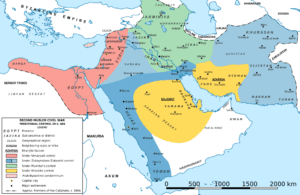
Second Fitna - Some records claim that Medina experienced looting, pillage, rape and murder following the conflict. After that, the Syrian army travelled to Mecca, where Abdullah had created his own domain.
- For several weeks, the city was under siege and, during that time, the Ka’aba’s (an Islamic holy site) cover caught fire.
- After their leader unexpectedly passed away, Yazid’s troops fled to Syria, but the harm they caused was irreparable in the eyes of Muslims.
- While his opponents were barely in control of Damascus following the death of their sovereign, Abdullah maintained his uprising for another 10 years, claiming the title of Caliph for himself and winning the allegiance of Hejaz, Egypt and Iraq.
- Muawiya’s cousin Marwan ibn Hakam, a prominent member of the Umayyad family, assumed the throne, promising that Khalid, Yazid’s younger son, would succeed him after his passing. Given that the Marwanids, commonly known as the Hakamites, now controlled the empire, he had no intention of honouring his word. Egypt, which had rebelled and joined the Zubayrid group, was retaken by Marwan. However, he was unable to stop Abdullah’s uprising since he passed away nine months after taking office. Abd al-Malik, his intelligent son, was now in charge of carrying out this assignment.
- Al Mukhtar instigated a rebellion in Kufa in 685 CE and allied himself with Abdullah to fight the Umayyads.
- Al Mukhtar meticulously pursued everyone connected to Husayn’s assassination.
- The united forces of the Kufans and Zubayrids routed an army sent by Abd al-Malik under the command of Ubaidullah (the general from Karbala). The vanquished general was put to death.
- Al Mukhtar was murdered by Zubayrid soldiers in 687 CE while Kufa was under siege.
- Al Mukhtar’s uprising finally resulted in the conversion of Shi’ism from a political movement to a religious sect, despite the fact that he passed away there and then.
- After the threat in Kufa was eliminated, Abd al-Malik turned his focus to Mecca.
- He dispatched his most devoted and brutal general, the renegade Iraqi governor Hajjaj ibn Yusuf, to crush his competitor.
- Despite having little chance against Hajjaj’s powerful army, Abdullah refused to give up and passed away with his sword in hand in 692 CE. This ended the conflict.
- Abd al-Malik built the Dome of the Rock in Jerusalem, probably to counterbalance his position against Abdullah, who was in charge of the Ka’aba at the time. Additionally, Tunis and the whole of North Africa were permanently occupied throughout his rule. During the rule of his son, the local Berbers who had embraced Islam would play a crucial role in spreading it all the way to Spain.
EXPANSION OF THE EMPIRE
- After Abd al-Malik passed away, his son Al Walid I took over and expanded the sphere of influence of his dominion. Two of Hajjaj’s protégés, Muhammad ibn Qasim and Qutayba ibn Muslim, were successful in bringing portions of modern-day Pakistan and Transoxiana under their control. Hajjaj continued to exert influence on his ruler. Beginning in 711 CE, when a Berber by the name of Tariq ibn Ziyad arrived on the Iberian Peninsula on a summit that still bears his name, Gibral-Tar, the Muslims began their conquest of Spain. At the battle of Guadalete, he routed the Gothic king Roderic’s larger force, and the region thereafter stood still for him to conquer.
- By 714 CE, Tariq and Musa ibn Nusayr, the ruler of Ifriqiya, had captured the majority of Al Andalus (Arabic for Spain, the Vandal homeland). Musa was about to invade Europe via the Pyrenees when, for reasons historians do not fully understand, the Caliph ordered the two of them to return to Damascus.
- Walid attempted to name his own son as his successor rather than his brother Sulayman, who was designated as such by their father’s covenant. Sulayman, of course, resisted giving up his claim. Walid passed away before he could subdue his brother, and Sulayman took over but his brief reign was a dismal failure. Sulayman had nothing but hate for the late Hajjaj and freed a large number of prisoners from Hajjaj’s jails.
- Sulayman, however, had many of the empire’s fearless generals and competent governors slain, since most of them had been selected by the aforementioned. As a result, the dead governor’s subordinates faced the full fury of the new Caliph. In 717 CE, Sulayman then turned his attention to Constantinople and dispatched a sizable force to seize the Byzantine city. This endeavour was an expensive and embarrassing failure: the damage was permanent and irrevocable, growth was stopped, and it was the first significant loss suffered by the Byzantines. Sulayman picked his devout cousin Umar ibn Abd al-Aziz as his successor as he was on the verge of death and knew that his own kids were too young to replace him.
- Because of his unshakable commitment to Islamic ideals and the rule of law, Umar II was only able to govern for three years until he was poisoned by his own family.
- Because he was frequently referred to as the fifth Rashidun Caliph, he achieved a posthumous reputation.
- Knowing that the internal condition of the empire needed to be repaired before anything else, he halted all military operations.
- In addition, he had begun talks with non-Arab Muslims who had rebelled against and despised Umayyad authority.
- There was a decent possibility that he may have succeeded given enough time, and the Abbasids may not have ever amassed sufficient support among Mawalis and Shia Muslims to overthrow the Umayyads.
- Yazid II, another son of Abd al-Malik and Umar’s successor, did not prove to be a more effective leader than Umar. While he was preoccupied fondling his favourite concubines in his harem, the empire had been completely lost to his inept rulers. Thankfully for the Umayyads, he passed away four years after taking power.
- Hisham, Yazid’s brother and successor, inherited a civil war-torn empire and vowed to use all his resources to restore order to the country. Hisham, a powerful and unyielding king, restored many changes that Yazid II had put an end to after they had been started by Umar II.
- Some of his military campaigns were successful, while others were less so. For example, a Hindu uprising in Sindh (a region in modern-day Pakistan) was put down, but in 739 CE a Berber uprising broke out in the western sections of North Africa (modern-day Morocco). The Kharijite fanatics’ zealous preaching had incited the Berbers, who then inflicted significant damage, most notably the massacre of the majority of the Ifriqiya’s Arab aristocracy at the Battle of Nobles near Tangier. The Umayyads lost control of Morocco, although attempts to put down the uprising fell well short of their goal. The dispersed Berbers quickly fell apart after failing to capture the central part of Ifriqiya, the capital of Qairouwan.
THIRD FITNA AND THE FALL OF THE EMPIRE
- The empire descended into civil conflict following Hisham’s death in 743 CE. Walid II, a son of Yazid II, governed from 743 to 744 CE before being deposed and assassinated by Yazid III, a son of Walid I. This led to the Third Fitna, the third civil war in Islamic history, as several tribes had begun to rebel against the ruling class during the ensuing instability. The old Marwan II, a grandson of Marwan I, overthrew Yazid III after just six months in power. Ibrahim, who had replaced Yazid III, was only able to govern for two months.
- Marwan II, a capable military leader but a lacklustre diplomat, put a stop to the Third Fitna in 747 CE by using sheer force to quell uprisings. However, the Khurasans had turned to the Abbasids, an Arabian group who claimed to be descended from the Prophet’s uncle Abbas (in Iran). His army was worn out from years of fighting, the collapsing economy prevented him from raising additional men, and inept governors failed to recognise the seriousness of the Abbasid danger until it was simply too late. His empire was not prepared to deal with a large-scale insurrection.
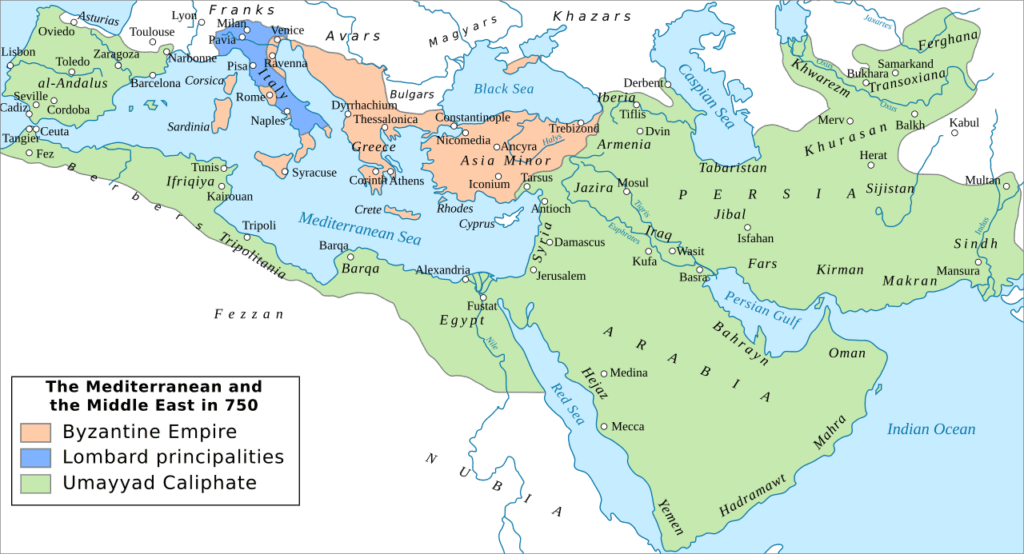
Umayyad Empire before the Third Fitna - By the end of 749 CE, the majority of the eastern nations had adopted the Abbasids’ black flag, and the disgruntled tribes that he had brutally conquered had joined forces with them. In 750 CE, he encountered the majority of the Abbasid army close to the Zab River, where his army was beaten and he was compelled to escape. He attempted to gather his soldiers from the western provinces by fleeing to Egypt, but the Abbasids found and executed him. The Umayyad era had ended, and Abu Abbas, the first Abbasid monarch, had been crowned the new Caliph at Kufa.
- The Umayyads had no mercy from the Abbasids: all male members were killed, and the few survivors withdrew to their hiding places. All of the Umayyad burials in Damascus were dug up, with the exception of Umar II, whose grave was spared due to his renown. Then, under the guise of reconciliation, the Abbasids invited all of the surviving members to dinner. However, assassins burst into the room just as they were about to sit down at the table and clubbed them to death. A descendant of the shrewd Hisham, Abd al-Rahman I managed to flee the Abbasids and make a treacherous voyage through the empire before arriving in Al Andalus in 756 CE, where he established the Emirate of Cordoba, which matched the Abbasid kingdom in elegance and splendour.

